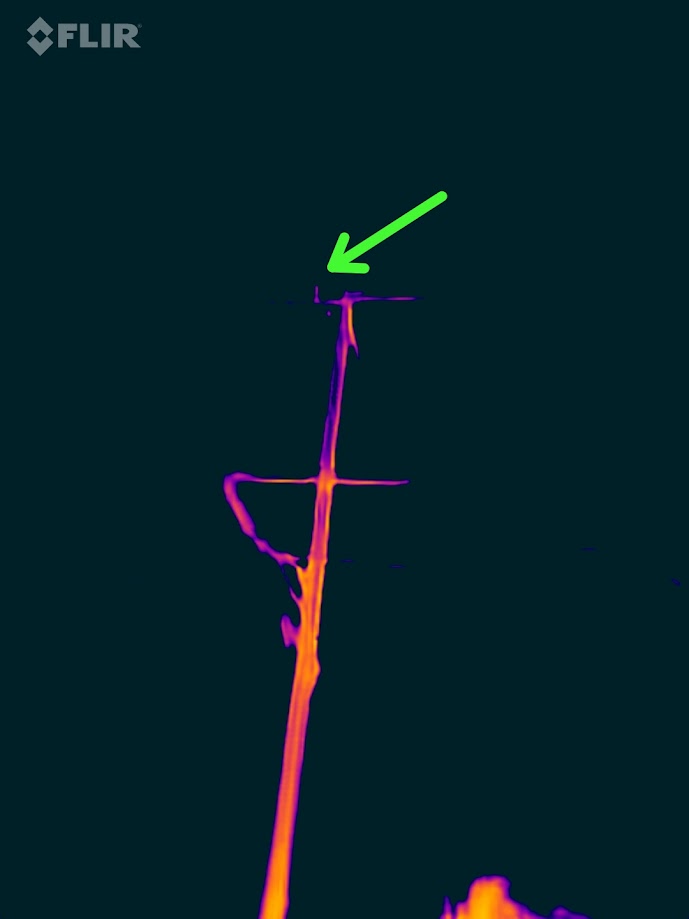I finally had a moment to pull up the waveform of The Buzz– PG&E’s faulty equipment producing radio frequency interference (RFI) in my neighborhood– and overlay a 60Hz sine wave on top of it:

As you can see, the bursts of noise align perfectly with a 60Hz sine wave. It would be astonishing if this were not powerline noise.
I also found on the ARRL’s examples of utility noise page, under the heading “w4tdk-13690 Powerline Noise” is a noise that sounds very similar to mine. From their description:
Torbjorn received excellent service from his local power utility. Power was turned off for several blocks around his QTH, and the noise was eventually isolated to a ground wire on pole-mounted lightning arrestors that had burned through in two places and were just barely making contact. The wire was repaired and the noise disappeared. The customer (W4TDK) is happy, and the power company fixes a potentially dangerous situation. Everyone wins!
Unfortunately, I have not received excellent service from my local power utility, PG&E. They continue to ignore the problem, and just this morning they had a catastrophic failure of some piece of equipment (due to neglect, no doubt) on the other side of our neighborhood that cut power to about 900 customers. One notable difference with W4TDK’s recording is that his noise comes in 60 pulses per second rather than 120; it’s only pulsing on one side of the sine wave; perhaps having a wire that’s just barely making contact was behaving a bit like a diode, sparking with current flowing in one direction, but not the other?

In my case, I suspect the problem is a faulty insulator, and I might have even located which one it is with my thermal camera. I’m fairly sure my neighbors think I’m nuts, but I snapped this image last night while it was fairly cold outside, and I’d set the low end of the range of my FLIR camera high enough that most objects did not show up at all in infrared, except for a little heat given off by warm patches of road, houses, cars, trees, and this utility pole:

Note that this utility pole has a number of insulators on both the crossbar on the top and the middle. You can’t see most of them because they’re just too cold. So cold, in fact, that you can see a dark shadow cast by the two on the top right if you look carefully. But on the top left, at the end of the green arrow, one insulator is just warm enough to be visible.
Now it’s certainly inconclusive, and in no way is this proof of a faulty insulator, let alone the one that seems to be warm. There are many reasons this particular insulator might be showing up while the others do not; it could be something else that happens to be reflecting off its surface from the position where I happened to be standing, or it could be that had I stood in a different position, a different insulator would have been visible, just an accident of optics and positioning. It’s not impossible, though, that this insulator is faulty, and that it’s warm because there’s a current arcing across it 120 times per second for 1.5ms – 3.75ms each time (I don’t know why sometimes there’s just one quick pop, and sometimes a double pop which you can see in the waveform, other than perhaps just random chance).
Another observation is that ambient temperature and humidity may be a factor, possibly temperature more than humidity. Above about 60 degrees Fahrenheit, The Buzz is much less prominent than it is at 60 degrees and below, but I do not have enough data to say this is more than a coincidence; it could as easily be the case that it’s a function of how much electricity is being consumed in my neighborhood, and people consume more when it’s colder outside. Or it might not be a real pattern at all.
At any rate, the saga continues, and in a few days I’ll make my weekly call to PG&E to check on the status of my open ticket. As of last week, nobody had even looked at it, 24 days after it was opened…